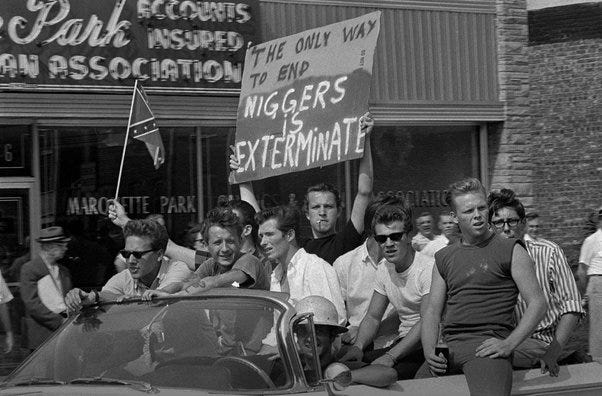Yesterday The Washington Post published a lengthy piece about former Republican South Carolina governor and presidential candidate Nikki Haley’s complicated relationship with the Confederate flag. The article referenced videos that I commented on back in February. I am reupping that post, which includes a detailed history of the political backdrop of the flag in South Carolina going back to the 1960s. The truth is that both Democrats and Republicans have embraced Confederate memory (and the flag specifically) to further their political agendas. I don’t say this to engage in both-sidesism, but to suggest that the problem is more deeply embedded in our historical memory than focusing on any one political candidate can reveal.
[Originally published on February 16, 2023]
Former South Carolina governor Nikki Haley is running for president.
For many Americans, the defining moment of her time as governor was her support of removing the Confederate flag from the grounds of the State Capitol, following the murder of nine Black churchgoers in Charleston by Dylann Roof in 2015.
Haley has a complex relationship with the controversy surrounding the flag—one that she likely would rather put behind her given former president Trump’s embrace of white nationalists and praise of Confederate leaders like Robert E. Lee.
In fact, in a video announcing her presidential run, Haley makes no mention of her role in lowering the flag back in the summer of 2015. No doubt, she hopes not to alienate the Trump base and other constituencies who continue to rally around Confederate memory.
This is going to be difficult. The day after her announcement video surfaced of Haley meeting with the Sons of Confederate Veterans back in 2010.
When asked whether states have a right to secede, Haley responds in the affirmative though she also suggests that such a drastic decision will not be necessary.

Here she tries desperately to steer clear of the Confederate flag controversy while at the same time declaring that it is a symbol of “heritage” and not a symbol of racism.

There is little that is surprising here. If anything, it reflects the continued influence of groups like the SCV even as recently as 2010.
At the same time it represents a gross distortion of the flag controversy in South Carolina. This historical revisionism played out even more clearly following the Charleston murders following the publication of photographs showing Roof waving a Confederate flag.
[Thanks to Aaron Blake at The Washington Post for putting together a helpful timeline of Haley’s involvement in the debate during her time in office.]
Haley called for the removal of the flag only after a number of high-profile Republicans came out in favor of removal. My issue with Haley is not that she hesitated over this issue. She did what most politicians do when it comes to controversial public questions like this one.
What I find egregious is her continued stance that somehow Dylann Roof had co-opted a symbol and turned it into something it wasn’t.
In November 2019 Haley wrote in her book:
The evil act he had committed had robbed the good-intentioned South Carolinians who supported the flag of this symbol of heritage and service. He had encouraged everyone’s worst stereotype for our state. Clearly, something had to be done. But at the same time, I worried that allowing the killer to define what the flag represented for everyone was a surrender. Why should he, of all people, be given that power?
The following month on the Glenn Beck show she double-downed with the following: “And here is this guy that comes out with this manifesto, holding the Confederate flag, and had just hijacked everything that people thought of. … People saw it as service and sacrifice and heritage, but once he did that there was no way to overcome it, and the national media came in droves.”
When in doubt, blame the media.
In an op-ed published in The Washington Post the following month Haley attempted to have it both ways:
For many people in our state, the flag stands for traditions that are noble — traditions of history, of heritage and of ancestry. The hate-filled murderer who massacred our brothers and sisters in Charleston has a sick and twisted view of the flag. In no way does he reflect the people in our state who respect and, in many ways, revere it. At the same time, for many others in South Carolina, the flag is a deeply offensive symbol of a brutally oppressive past.
Call it progress as much as damage control. By 2019 the nation was well in the midst of a national reckoning over Confederate symbols like the flag and monuments. White nationalists had rallied in Charlottesville in defense of a Confederate monument that led to the murder of Heather Heyer.
Nikki Haley will never understand that it shouldn’t have taken the murder of nine African Americans in a Charleston church to justify the removal of the Confederate flag from a public space that is supposed to be welcoming to all South Carolinians.
Dylann Roof didn't turn the flag from a symbol of tradition and heritage into one of hate. It had always been so. In fact, Roof understood all too well the Confederacy's legacy of white supremacy. Haley could have appreciated this if she had read a book or cared as much about her Black constituents as she did the Sons of Confederate Veterans.
This was a political choice.
Unfortunately, for a long time politicians in South Carolina could get away with ignoring their Black constituents as a result of disfranchisement and Jim Crow. Between 1902 and 1969 no African Americans held state office. This was true in 1962 when the Confederate flag was first placed atop the State Capitol in celebration of the Civil War Centennial.
While there is very little evidence that legislators placed it there as a symbol of resistance to civil rights, white citizens certainly would have understood it as such. It didn’t need to be stated. The Confederate flag was waved throughout the South during this period in response to Black marches, sit-ins, and other demonstrations.
In July 1972 the YMCA and NAACP called for the flag's removal from the State House. In 1980, the House defeated two bills aimed at removing the Confederate flag.
Again in 1987 the Southeast Region of the NAACP passed a resolution calling for its removal. These calls were accompanied by public addresses that included painful reminders of how African Americans experienced the Confederate flag during the civil rights era and in their daily travels.
Haley’s self-serving and revisionist story would have us ignore a history that was always staring at her and others in the face.
Politicians ignored how African Americans responded to the Confederate flag because they could safely do so in their campaigns for election and reelection.
Early signs of progress could be seen in 1993, when Democratic mayors in Charleston and Columbia called for the removal of the flag in Columbia.
But it was only after the election of a sufficient number of Black state senators in the 1990s, including Kay Patterson, Robert Ford, Maggie Glover, and Darrell Jackson as well as Representative Joe Brown that a compromise was arrived at after negotiations with Sen. Glenn McConnell, John Courson, and Verne Smith, all members of the Sons of Confederate Veterans.
The compromise would include removing the flag from atop the State House Dome, placing a square Confederate battle flag at the Confederate Soldiers Monument in front of the State House, and placing a Confederate First National Flag at the UDC Monument. The compromise also called for new legislation protecting Confederate monuments throughout the state.
The plan failed to win sufficient approval before the end of the legislative sesssion.
Nikki Haley would have us believe that she was the first Republican governor to call for the removal of the Confederate flag, but she was not. In 1996 Republican Governor David Beasley signed a bill authorizing the erection of an African American Monument on the State House grounds. He also called for the removal of the Confederate battle flag.
Beasley lost reelection, in part, because of his position on the flag.
Though Democrat James H. Hodges won the gubernatorial election in 1998 with the support of African Americans, he pledged to Confederate heritage groups that he would not push for the removal of the flag. The following year the NAACP called for an economic boycott of South Carolina. While the economic impact was marginal, but the public relations impact was significant.
Continued media attention forced Governor Hodges to eventually change his position. In 2000 he signed the senate's Heritage Act, which removed the Confederate flag from the dome and placed a square battle flag on a flag pole next to the Soldiers Monument.
The legislation also recognized both Martin Luther King Jr.'s birthday and Confederate Memorial Day as state holidays. Finally, it prevented the removal or alteration of any monuments or memorials located on the state's public property.
Little would change over the next decade.
I suspect that at some point during the campaign Haley will be pressed to address the continued controversy surrounding the flag and Confederate monuments. Perhaps she has learned something over the past few years. Hopefully, she won’t fall back on the same poor attempt at both-sidesism.
Hopefully, Haley understands that a presidential bid means that she is no longer sitting in a room with the Sons of Confederate Veterans.
We shall see, but for whatever it’s worth, I am not optimistic.









Very good article. I had avoided reading the WaPo article, but you compelled me. Two highlights:
“Even in calling for the flag’s removal, though, Haley still did not criticize what it represented. Instead, she said that while some viewed the flag as a ‘symbol of respect,’ others saw it as a ‘deeply offensive symbol of a brutally oppressive past.” She said South Carolina could still be “home to both of those viewpoints. We do not need to declare a winner or loser here.’
“However, another Republican, state Sen. Paul Thurmond, son of the segregationist U.S. Sen. Strom Thurmond, said in his floor speech that, ‘Our ancestors were literally fighting to continue to keep human beings as slaves and continue the unimaginable acts that occur when someone is held against their will. I am not proud of this heritage.’
“Very good people on both sides...” ugh. No wonder she became dt’s UN ambassador. And when even the son of Storm Thurmond gets it. SMDH
“But the years of delay angered those who had gotten nowhere with Haley on the flag issue until after the massacre.”
“Gallman, the former South Carolina NAACP president, said that if Haley had spoken up years earlier, she might have gotten the flag removed entirely from the State House grounds — and perhaps sent a message that reached people like Roof.”
I feel the anger, but I think Roof was on his path from birth.
Kevin,
Excellent article. You mention everything that I would if I wrote it. The irony is that had the Confederacy won she would never had the opportunity to be Governor, but because she is both mixed race and female, she would be lucky to be the night manager at a 7-11.
Peace,
Steve